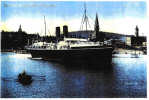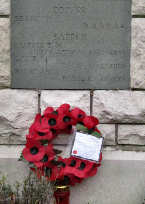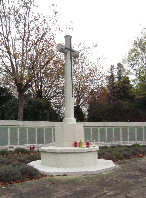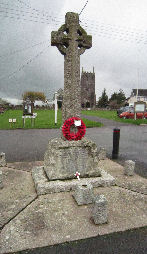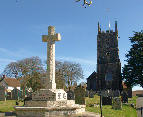
|
| HOME PAGE |
| MEMORIAL CROSS |
| HISTORY of the CROSS |
| ROLL of HONOUR |
| LINKS |
| Driver Percy Beardon 133460 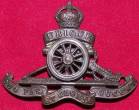 27th Reserve Battery, 27th Reserve Battery,Royal Field Artillery, 32nd Brigade, 4th Division. Drowned at sea following the sinking of the RMS Leinster Died 10.10.18 aged 31. Percy Beardon was born at Pensford, Hollocombe, on 2nd January 1887, the son of John and Elizabeth Beardon, and the second of four children. Pensford was a pair of cottages at the bottom of a hill about three-quarters of a mile from Hollocombe village and near the stream that runs at the bottom of the village. John Beardon, born in 1854, and originally from Wembworthy, was a Bootmaker. The 1881 census records that John was living alone at Pensford, but he was about to be married and move to Pensford. He descibed himself then as earning his living as a cordwainer, but this was rather wishful thinking as he remained a Bootmaker all his life. He married Elizabeth Bradford who was born in January 1858. She died in June 1946, aged 88 years, having lived her life through two world wars, and losing her son Percy in the first. John Beardon died in December 1927, aged 73 years. After their marriage on 12th September 1882, Elizabeth and John continued to live at Pensford, and John's brother William and his family moved into the other Pensford cottage. John and Elizabeth’s first child, Charles, was born in 1885. Charles’ granddaughter, Rita Beardon, still lives in Hollacombe. After Percy, their third child Herbert, was born on 11th October 1888, also at Pensford. Some time not long afterwards, the family moved up the hill into Hollacombe, because Elizabeth was now running the Hollacombe sub-post office, which combined with the village shop selling small items such as sugar, flour, tobacco and cigarettes. Here, the fourth child Hetty was born on 29th April 1894. In common with the other children, Percy attended Hollacombe School until the age of 13 or 14, leaving in 1901 or 1902. The Winkleigh Board School had been taken over in the year of Percy’s birth by Mr and Mrs. James Tipper and was in as good a shape as was possible, but Hollacombe School, very much smaller of course, was a different matter. With only one teacher, and with many changes of staff, the education programme must have been rudimentary and uncertain. In 1894 when Percy was six, the Minutes of the School Board record that the numbers on roll were about 40 – a huge number for a tiny building, and efforts were made to try and force the older children to walk every day to and from Winkleigh, a long and tiring journey especially in cold or wet weather. In 1894 a Fanny Smale was appointed as Mistress, on £50 per annum, but she had almost no qualifications for the job apart from limited training as a monitor. She lasted about six weeks before either resigning or being dismissed. In desperation the Board raised their offer to £65 and even to £70, but by the following January they could only find a temporary lady who was paid weekly at £1, on virtually no contract. In January 1895, Percy now aged eight, would have known a more permanent Mistress, Miss Lucy Snell, who remained for a while at £50 per annum. Hetty clearly benefited from the more settled conditions at Hollacombe School. She went on to marry Samuel Burd (who was born under the name of Bird) in March 1900. On 11th May 1911 Hetty, at only just 17, became the Sub-Office assistant to her mother. She was appointed Sub-Postmistress on the 14th December 1927 following the retirement of her mother from that position. After 53 years of service Hetty finally retired in May 1964 after 53 loyal years of service to the Post-Office, duly acknowledged with a Certificate of Service and a fine letter of congratulation. Hetty and Samuel’s son, Gordon Burd, retired from the Police service and living in Exeter has been an invaluable source of information on his family, supplying many of the photographs which are included on this web site. We are extremely grateful for all his help and interest in recording the life and tragic death of his uncle Percy. By the age of 14, and as recorded in the 1901 census, Percy had already left home and was working and lodging at Wood Terril farm as a farm servant, no doubt fully involved with the horses. William Cowle who employed Percy was a very important man in the district. His household consisted of his wife, four children, a domestic servant and two farm servants, and probably other day labourers. By 1911 Percy, now aged 23 had moved, working as a horseman on the farm of Frank Hutchings at Lower Narracott, Ashreigney. On April 13th 1916, aged 31, Percy enlisted in the Royal Field Artillery, just before the Conscription Act of 25th May 1916 became law. He might well have already registered under the Derby Scheme (a last ditch attempt by Asquith’s government to avoid conscription). Men under 35 were invited to register, on the understanding that the bachelors would be taken before the married men. Voluntary enlistment brought the reward, at least in theory that a man could choose the branch of the army, and sometimes a regiment, in which to serve. By contrast, after May 1916 everyone not in a reserved occupation or otherwise excluded was drafted. With the inevitability of conscription fast approaching, Percy left it to the last minute to enlist, thus avoiding the infantry and opting for the artillery. The photograph of Percy Beardon loaned to us by his nephew Gordon Burd is revealing. It is clearly a typical ‘enlistment photo’ - men wanted to be photographed in their new uniforms, standing proudly in a studio, for distribution to their families and loved ones. This one was taken in a studio in Winchester High Street, so we can be certain that Percy was stationed near Winchester for his basic training as a driver in the Royal Field Artillery. On the back is written:
There were three training depots in Winchester - the Heavy Artillery Training Centre, No.1 Reserve Brigade (Heavy) and No.2 Reserve Brigade (Heavy). It is possible therefore that Percy was first enlisted into the Royal Garrison Artillery. Heavy Batteries RGA were equipped with 60 pounder (5”) guns. The guns were horse-drawn, usually in teams of 8 horses with four drivers per team. As British artillery tactics developed, the Heavy Batteries were most often employed in destroying or neutralising the enemy artillery, as well as putting destructive fire down on strongpoints, dumps, stores, roads and railways behind enemy lines. At some point Percy must have transferred into the Royal Field Artillery, and was posted to the 27th Reserve Battery, then serving in France with 4th Division. Besides the photograph, and among his family effects, Gordon Burd was also able to show us a letter written by Percy Beardon to his mother, during the war. It reads as follows:
* The ‘Will’ referred to is not identified. It could refer to William Darch, who also enlisted in the Royal Field Artillery, survived the war and afterwards became a coal-miner in South Wales for a time, because of the general unemployment. ** A possible reference to Mrs. Lucy Lock, wife of William Lock, a farmer, living in Cleave Dolton. £1 was equivalent to a week’s wages, and would therefore be a gift from someone of substantial means. ‘More than a lot would do’ seems to indicate ‘more than a lot of employers would do’. In the 1911 Census Lucy Lock is described as ‘assisting in the business’, no doubt on the accounts side. It is therefore possible that Percy was working for William Lock at the time of his enlistment. Since the year is not recorded, the first problem with the letter is to try and establish in which of three possible years - 1916, 1917 or 1918 the letter was written. We look first at the possibility of October 1916. Percy includes himself as classified ‘B3’, which means either his health or physical fitness was poor and might well have kept him back on ‘home service’ rather than being sent in a draft to the front. (Army medical classifications ranged from A1 right through to C3.) The 27th Reserve Battery had in fact been detached from Home Service in Ireland at the start of the war, to join the 32nd Brigade on active service. The Depot for the 27th however was Athlone, Ireland. Thus, if the letter was written in 1916, the scenario would be that Percy did 6 months basic training in Winchester, followed by 7 or 10 days leave and a posting (as a B3 man) to the 27th Battery Depot at Athlone, where he remained for two years. It is unlikely that travelling to Ireland he was part of a draft (reference to ‘the biggest part of them was sick’ probably refers generally to the other troops on the boat) and also because he was travelling alone, unaccompanied by an officer or senior NCO - otherwise his late arrival would not have caused him to appear before the Colonel on a charge (technically a possibly serious charge of absence without leave). On his own, he regarded changes to his army travel arrangements as ‘messing him about’ on this small adventure of a posting out of England and having to cross the Irish Sea. It is also interesting that a Mrs. Lock gave Percy a one-pound note - this was much more than he would have been earning for a whole week before enlisting. It sounds very much like an affectionate farewell to a man going abroad after embarkation leave. On the other hand there is one important item in the letter which could argue strongly against 1916 - the reference to progress on the ‘Wipers’ front (the Ypres Salient), and the possibility of the war ending by Christmas. This rules out 1916, as in the September the British army was still involved in the Battle of the Somme, with absolutely no prospect of the war’s end, let alone victory. Similarly, we can rule out 1917 - by late September 1917 the Passchendaele offensive could hardly be presented by the propaganda media as some sort of an advance. In August 1918, however, the major British, French and American offensive had begun which brought the war to an end, and the first battles were being fought in the Salient (the ‘Wipers’ front). Hopes were high for a general advance and an end to the war before too long. If we are looking then at 1918, difficult questions are raised. First, what was Percy doing during the two years between basic training in Winchester and his posting to the Depot in late September 1918? His medal record (Victory and British medals) tells us no more than we know already. Second, was the classification ‘B3’ awarded at the outset of his service or possibly because he had been wounded or sick on active service? Third, why, having arrived at the Depot in late September was he then returning to England only two weeks later? He was certainly not going on leave - he had just had 7 or 10 days - so he was being posted. He mentions the rumour of a posting to an anti-aircraft Battery, this is quite possible as all ‘fit’ men on Home Service were being ‘combed-out’ as reinforcements to replace the horrendous casualties of the 1918 campaigns. Alternatively, and despite his B3 classification, Percy might even have been posted back to the 27th Reserve Battery in France, but since he was travelling on his own this is highly unlikely. The casualty list from the RMS ‘Leinster’ records only 6 men on board from the Royal Field Artillery. It is clear from the list that once again Percy, whatever he was doing, he was not part of a draft. The list comprised: 133460 Driver Percy Beardon, 27 Reserve Battery. Lost at sea, commemorated on the Hollybrook Memorial, Southampton. The almost certain likelihood, then, is that the letter was written in October 1918, one week in fact before his death. As such, and as the last letter received from him by his parents, it would have been a treasured relic of his lost life. In that case we can be sure that Percy’s two ‘missing’ years were undoubtedly spent serving with the 27th Reserve Battery in France, 32nd Brigade RFA, 4th Division, (the Brigade consisting of the 27th, the 134th and the 135th Batteries). The ‘Wipers front’ would have been well known to Percy, because the 32nd Brigade took a full part in the Passchendaele offensive of 1917. In 1914 the 4th Division, newly formed and consisting of regular army battalions many of whom were withdrawn from around the Empire, was initially planned to be part of the original British Expeditionary Force, but at the last minute was held back in England to counter any German landing. A decision was soon taken to dispatch it to France and it arrived just in time to play a valuable part at Le Cateau. The 4th Division then remained on the Western Front throughout the war. The First World War was dominated entirely by the artillery. Artillery caused the most terrible wounds, the greatest loss of life and usually the greatest stress to anyone serving in the front line, while at the same time artillery brigades suffered far fewer casualties than among the men serving in the infantry. In the British army, the horse-drawn RFA was responsible for the mobile artillery of the time, the 18lb field gun and the 4.5 inch howitzer. In 1914 a Divisional artillery consisted of 3 Field Brigades and 1 Howitzer Brigade. In May 1916 this arrangement was changed; its howitzer sections were broken up and allocated to join the Field Brigades, usually of the same Division. The 32nd Brigade, for example, created a 4th battery (D) by taking in 2 sections of 2 guns each from the 86th Howitzer and the 128th Howitzer Batteries. Later, in January 1917 one of each Division’s three RFA Brigades was taken under ‘Army control’ - that is, they were put at the immediate disposal of the Divisional Headquarters, to be used for example as part of the Divisional reserve, to be moved to any part of the Divisional front requiring extra support. A RFA Brigade (roughly equivalent of a battalion in the infantry) was commanded by a Lieutenant-Colonel with his Brigade HQ, commanding three batteries (A, B and C, later with D as well) and an ammunition column. Each battery (equivalent to an infantry company) was commanded by a Major or Captain. A battery consisted of 6 guns divided into 3 sections of two guns each, commanded by a Lieutenant or newly joined 2nd Lieutenant. Each battery (at full establishment) ideally numbered 198 officers and men, including the Battery Sergeant-Major, a Battery Quartermaster-Sergeant, a Farrier-Sergeant, 4 Shoeing-Smiths, 2 Saddlers, 2 Wheelers, 2 Trumpeters, 7 Sergeants, 7 Lance-Bombadiers (Lance-Corporals), 11 Bombadiers (Corporals), 75 Gunners, 70 Drivers and 10 Batmen, usually Gunners. Usually, of course, batteries were often short of their establishments, both in guns and in manpower as losses could not always be quickly replaced from the depots and training units. Reinforcements of men would usually arrive in drafts during periods of ‘rest’, brought out by junior officers just joining or others returning from leave, or by senior NCOs. As with all units of the regular army, the 27th Reserve Battery would have very soon consisted of both regular army troops and newly joined recruits, certainly from October 1914 onwards. In similar fashion, as the war progressed, the regular army RFA units attached to regular army divisions would be increasingly mixed with Territorial Army units and New Army units. To summarise, the 27th Reserve Battery of the regular army, with its depot at Athlone, had been detached from Ireland at the start of the war, and was serving with the 32nd Brigade RFA, 4th Division, 17 Corps, 3rd Army of General Sir Julian Byng. Without further direct evidence, but assuming that the letter was written in 1918, and that Percy Beardon had been serving in France with the 27th Battery for some two years, he must have been wounded in action sometime around the beginning of the year. After hospital and convalescence in England, and now classified as B3, Percy would first be sent on leave before returning to the 27th Battery Depot prior to a Home posting where he could replace a fitter man. There is indeed in the War Diary of the 32nd Brigade RFA an indication that Percy might well have been wounded some six months before. On 27th February 1918, the 32nd Brigade was in reserve at Fricourt, (as it happened in the area of the old British front line as it was at the start of the Battle of the Somme on July 1st 1916). From there, on March 24th 1918, the Brigade, including of course the 27th Battery, moved up the line to Monchy, to meet the great enemy attack (operation Mars directed towards Arras) and was in position just north of the Arras to Cambrai road. The war diary records that on 28th March the Germans used gas and high explosive shells to blast the roads, bridges and communication trenches in the area, as a veritable ‘storm of steel’ descended on our troops. The 27th Battery was ‘practically neutralised’ by a 5.9 and 4.2 howitzer battery. The German infantry attacked at 7.00 a.m. and the Brigade’s task was to support 10th Infantry Brigade in the defence. It is recorded in the Brigade War Diary that ‘Observation on the enemy was good but communication was very difficult as the telephone cables were cut in the preliminary bombardment’. In this first engagement, the Brigade lost two officers wounded, fifty other ranks killed, 16 other ranks wounded and 4 guns put out of action. It is tempting to think that perhaps Percy Beardon was one of those wounded on 28th March, as we already know that the 27th Battery suffered badly, losing perhaps the 4 guns already mentioned. If Percy was one of those hit, the timing could fit with that of a six month's convalescence before returning as a B3 man to his Depot. To finish the story of the 27th Battery, by 9th April the whole Brigade was back at Montescourt, supporting 11th Infantry Brigade. In May, the Brigade war diary reads: ‘a few reinforcements joined the Brigade, chiefly men who had been sick or wounded and had returned to the line.’; The German advance was halted. By June the Battery was at Hinges and Cantraine, supporting 3rd Division. Interestingly, we learn that the Brigade was much affected by a form of ’flu known then as ‘three day fever’, short but virulent, in effect the start of the ‘Spanish ’flu’ disaster. In July the Battery was at Bellerive and Pacaut Wood. The diary summary for July reads: ‘The conditions of living in the Batteries were excellent. The gun positions had strongly fortified cellars and concrete shelters for the men. The limber lines at Contraine were comfortable, and the wagon lines at Bourecq were comfortable in the dry and dusty weather. The food for the men was very good with plenty of variety in the fruit and vegetables. The attack of the three day fever was pretty severe, well over 50% were down with it. The horses were at their best. The reinforcements were good and the remounts satisfactory.’ The story of the 32nd Brigade in the final months of the war illustrates only too clearly why the casualty figures suffered by the British Army in 1918 are, astonishingly, the highest of any year of the war. By August 1918 the Germans were retreating. The Battery was now at Hinges on the canal bank and advanced to support the infantry. 8th August: ‘As the infantry advanced our batteries got (an indication of) the front line each night from the liaison officer who was with the battalion commander in charge of the advanced battalion, and we fired on machine gun emplacements and posts held by the enemy’. On 24th August the Brigade was due for rest and training but this was cancelled in view of the rapid development of the British advance, supporting the 11th infantry Brigade in the crucial attack on the Drocourt-Queant line. This three days battle was, however, not without loss – 12 other ranks killed or wounded together with 6 horses. The Brigade then moved into reserve at Tilloy and Savy. Altogether, between August 26th and September 3rd, the battalion lost 4 other ranks killed and 25 wounded, with 17 horses killed and 20 wounded. It is revealing of the power of artillery on both sides that the diary reveals that ‘During these nine days, although none of the battery positions were under direct fire, most of the casualties were caused by a single shell. The German response to the attack on the Drocourt-Queant line was very slight. Movement of horses and men was increasing all day, yet hostile shelling was slight and apparently by map on selected areas, hence countless opportunities of stopping traffic and inflicting casualties were missed....’ The Germans were obviously in confusion, but the Brigade commander, in his turn, was also complaining about the lack of reliable information about what exactly was happening. In his August summary he grumbled: ‘The importance of personal reconnaissance by Brigade and Batteries with a view to obtaining information was emphasised, as even from the Infantry Brigade it was difficult to get reliable information concerning our own infantry, and extremely difficult for a Brigade Commander to continue the duties of a Group Commander, to keep close to the infantry....’ The British advance continued. The diary mentions ‘The front is largely flooded - a few bridges are passable and the roads leading to them.’ The horses were always the most vulnerable and it is almost unimaginable to realise the terrors often faced by the poor animals. On September 24th ‘Two bombs fell on the 86th Battery wagon lines. 20 horses were killed and 20 were evacuated.’ September 27th saw the 11th Infantry Brigade attacking astride the Arras-Cambrai road, assisted by the Brigade discharging smoke which was ‘very successful and served several useful purposes in the attack. The wind was just right and the screen was kept up from dawn to dusk. It absolutely prevented observation from the heights on our left of the movement of our guns on the right, and the advance of our infantry north along the Eastside of the Canal du Nord. The men worked very keenly, 1 OR killed.’ The next day a creeping barrage was fired - the 27th Battery alone fired 480 rounds. There was no shortage of ammunition - the next day, the 28th, another 480 rounds were fired. The last six weeks of the war were not only mobile, they were extremely costly, with casualties to men and horses occurring right up to almost the final hour. On October 6th the Brigade was relieved by the 4th Canadian Brigade RFA, a part of the 2nd Canadian Division. For a few days the 27th Battery was in training with the 11th Infantry Brigade, but the ‘rest’ was short and on October 8th/9th they were in action north-west of Cambrai at Morenchies. The diary relates ‘The Brigade was now engaged in moving warfare. There were considerable casualties to the horses owing to a few shells getting amongst the wagon lines. 7 ORs were killed, 11 wounded and 6 gassed. 25 horses were killed in the Batteries and at Brigade HQ 2 horses were killed and 2 wounded.’ At last the war ended, with the Brigade having reached Coron on November 11th. For the time being the horses could at last graze on the fresh grass fields and sleep sheltered under cover, while the men were settled securely and comfortably in barns. No ‘holiday’ however was allowed. An inspection of the Division by the Commander-in-Chief, Field-Marshal Haig, was announced, and rehearsals and ‘spit and polish’ began. In between whiles ‘sports and football are in full swing’. The diary summary for November reads: ‘During the month the Brigade had several large drafts of reinforcements, mostly men who had returned after being wounded or sick’. Sadly, Driver Percy Beardon was not among them. It continues ‘Many horses had to be cast and at the beginning of the month a large number were killed and wounded. The remounts sent to replace them were varied in quality, some very poor and in bad shape whilst others were in good condition. Casualties to the Brigade, considering the heavy fighting they took part in, were very slight.’ It is, I suppose, a matter of comparison to write in this way, not a matter of indifference, but for the families of those who died in the last days of the war, the tragedy must have been especially severe. Winkleigh’s own Percy Molland himself died on the last day of the war, and Percy Beardon only a month before the end. The details regarding the sinking of the RMS Leinster on 10th November 1918 and the lists of military personnel on board are all taken from ‘Torpedoed! The RMS Leinster Disaster’ by Philip Lecane, published in 2005 by Periscope Publishing Ltd, Penzance, Cornwall. Mr. Lecane‘s study of the tragedy is a memorial to the men and women who perished, to those that survived and to those who took part in the rescue operations, to those attending to the wounded and comforting the bereaved, and to those who made the subsequent arrangements for the burial of the victims. This hitherto little known incident at the end of the war has been rescued from obscurity and given its rightful place in the events of 1918. Had the sinking not occurred it is possible that the armistice might have been concluded some few weeks earlier, with the subsequent saving of many lives lost in the last days of the war. Together with three other vessels, the ‘Connaught’, ‘Munster’ and ‘Ulster’, collectively known as ‘The Provinces’, the Royal Mail Steamer ‘Leinster’ was employed on the mail run between Kingstown, Co. Dublin and Holyhead in Wales. In 1914 the ‘Connaught’ was requisitioned as a troop ship, but was torpedoed and sunk on 3rd March 1917 in the English Channel, while returning from France, luckily with no passengers aboard. The ‘Leinster’ was a twin-screw three decker, built in 1897 by Laird Bros., Birkenhead, and belonging to the City of Dublin Steam Packet Coy. On 10th November, the ship left Kingstown carrying 771 passengers and crew, including the Post Office sorters in the ship‘s mail sorting office. Unrestricted submarine warfare against all merchant shipping had been resumed by Germany in 1917, in an attempt to bring the war to an end by blockading the allies. In retaliation, the convoy system was devised for the Atlantic, but the protection of individual vessels in home waters was much more difficult. The danger of German submarines operating in the Irish Sea was always present: apart from her camouflage and carrying the light armament of a 12pdr gun mounted at the stern operated by Royal Navy personnel, the only defence for an unescorted vessel was to run a zigzag course to make it much more difficult for a submarine operating below water to attack. The war, however, was clearly in its final stages and although the mail steamers had been attacked from time to time, up until then none had been sunk. Very soon after leaving Kingstown, however, the ‘Leinster’ was torpedoed twice by Submarine UB-123, with the loss of 501 passengers and crew including a large number of military personnel. This number was the calculation of the ship‘s owners: there are, however, minor confusions, for example the military authorities couldn‘t disclose the fact that 18 Australian soldiers boarded the ‘Leinster’ without their names being recorded. These men were late arriving on the quay, the ship was ready to depart on schedule, and they were hastily put on board. Passenger lists didn‘t survive the sinking. After exhaustive research, Mr. Lecane concludes that as far as military personnel were concerned, out of a total of 771 people on board, 493 were military, 340 of whom were killed and 153 survived. These included the first WREN killed on active service. In all, including the civilians, there were 529 lives lost. The ‘Leinster’ left her berth in Kingstown harbour at 8.50 am, heading into weather that on that day was rough with a heavy sea, somewhat similar to the conditions Percy Beardon had related in his letter describing the journey out from Holyhead some five weeks earlier. On the other side, at Holyhead, Anglesey, Royal Naval Ships were confined to port, although a sister ship the RMS ‘Ulster’ had left Holyhead at 7.00 am and was on her way, and at about 9.50 am was seen on the horizon by passengers on the ‘Leinster’. The time was 9.50 am, and the ‘Leinster’ was just 7 miles E.S.E. of the Kish Light vessel. Percy would almost certainly have been on deck, trying to avoid sea-sickness and enjoying the companionship of newly-made friends. The ‘Leinster’ was taking a zigzag course when the first torpedo passed harmlessly in front of her bow. The second struck the vessel on the port side. The explosion burst through the mail sorting office with the torpedo exiting on the starboard side. Holed in two places, the ship rapidly began to settle by the bow. All hands were ordered to the life-boat stations, as Captain Birch ordered the ship to turn round with the intention of trying if possible to limp back to Kingstown. Captain Ramm of UB-123, however, was determined to complete his attack and fired a second torpedo, which smashed into the engine room. There was considerable confusion in the launching of lifeboats and attempts to give priority to women and children, with accounts of extreme heroism combined with a few frightening examples of utter selfishness and total panic. Mr. Lecane has brought the story of those terrible and frantic moments to life: one of the most shocking events he describes was that one of the first lifeboats away contained only four or five of the crew who did not pick up any survivors. A Sergeant who refused to relinquish his seat in a lifeboat waiting to be lowered was first warned and then shot dead by a military policeman, whereupon other soldiers who had also taken their seats got out. The boat was then filled with civilians and lowered. Two small aft boats on the starboard side managed to get away. A larger boat already filled was smashed to pieces when the second torpedo struck, while at the same time another turned over and of the hundred or so in it only six survived. A few life-rafts were thrown overboard, but four minutes after the second torpedo struck, the ‘Leinster’ sank. In all it seems that only four boats got away and of these only three were properly filled. For the rest, those who still survived were left floundering in the water. It is quite probable that Percy Beardon couldn’t swim - few in Winkleigh and on the farms had any opportunity of learning. With a lifebelt he might have lasted a while: without one there was no chance at all. Mr. Lecane relates (p.63): It took about two and a half hours for the first rescue ships to arrive, HMS ‘Mallard’ and HMS ‘Seal’, who had both spent the night at sea on patrol. The ‘Mallard’ received the SOS message at 9.42 am and while racing to the spot heavily damaged her fore bridge with heavy seas. Rescue operations began at 10.35 am; the whaler was lowered to pick up survivors. The destroyer HMS ‘Lively’ arrived on the scene at 11.12 am. Sadly, in attempting to bring on board survivors from ‘Big Bertha’ the life-boat overturned and many more lives were lost including that of Captain Birch who had been blown off the bridge and rescued from the sea. HMS ‘Seal’ also launched its whaler, but a smaller boat, a skiff, was overwhelmed by the mass of people trying to get into it and its crew managed to swim back only with great difficulty. On all the ships everything possible was done of course to revive the survivors and preserve their lives before they could reach the medical help that was waiting for them at Victoria Wharf, Kingstown, where the ferry terminal now stands. A military cemetery at Grangegorman was opened to receive the bodies of the 144 soldiers who were retrieved from the sea: 3 of the Field Artillery men who died in the tragedy are buried there. Other bodies were taken for burial to Britain, Canada and the United States. Those whose bodies were never retrieved, including Driver Percy Beardon are commemorated on the Hollybrook Memorial, Southampton, dedicated to military personnel 1914-1918 who died at sea. The most illustrious name that is inscribed there is that of Field-Marshall Lord Kitchener, Secretary of State for War, who drowned when the cruiser ‘Hampshire’ struck a mine in June 1916, while he was on his way to Russia for an official visit. The final end to the story is again a tragedy, this time for the German crew. On October 19th, 9 days after the ‘Leinster’ was sunk, UB-123, attempting to return home, struck a mine in the North Sea, part of the Norway-Scotland barrage. Captain Ramm and all his crew were lost. There is evidence to show that the sinking of the RMS ‘Leinster’ might have delayed the war‘s end, or at least put the negotiations into jeopardy. If so, it was a double disaster. By October 1918 Germany was desperate to end the war, but by an armistice rather than the unconditional surrender that was an entrenched policy of the Allies. President Wilson had issued his famous ‘14 points’ in January 1918, and Germany seized on the opportunity this presented to implore the President’s help as a mediator, with every hope of success. Wilson was also anxious that Germany should emerge as soon as possible as a reformed but full member of the European state community - to act as a balance against France and as a renewed trading partner with the United States. To further her interests, Germany now accepted the 14 points immediately and in full: Clemenceau and Lloyd George by contrast greatly distrusted them, particularly their emphasis on de-colonization. On 6th October Germany formally requested President Wilson to open mediation proceedings. On 8th Wilson requested clarification on certain matters. Thus matters stood on the morning of 10th October, when the torpedoing of the ‘Leinster’ brought matters to a rapid halt. Extremely sensitive to the issue of unrestricted submarine warfare (a major reason why the United States finally entered the war in 1917), President Wilson replied to the German government on 14th October, refusing to proceed on the grounds that at the very moment the German government was seeking the assistance of the United States, unrestricted submarine warfare was continuing. Hurriedly realizing their mistake, on 21st October all German U-boats were summoned to return to port, their only legitimate targets remaining being allied warships attacked in daylight. Thanks to the huge efforts made by Philip Lecane to ensure the perpetual memory of those who lost their lives, the ‘Leinster Society’ was formed to arrange commemorations and to continue research. In 1991 the starboard anchor of the ‘Leinster’ was recovered from the wreck, and was mounted as a memorial very near the quay from which the ship had sailed. Plans are afoot to locate the port anchor, to be installed in similar fashion at Hollyhead. On 10th October 2001, the 82nd anniversary of the sinking was marked by a commemorative service at the anchor, while the 85th anniversary was celebrated by a joint ceremony between the towns of Kingstown (Dun Laoghaire) and Hollyhead. It was intended that the Winkleigh branch of the Royal British Legion would lay a commemorative wreath in memory of Driver Percy Beardon on the 91st anniversary of his death at the Hollybrook Memorial on 10th October 2009. The event had to be postponed because of the ill-health of Percy’s nephew Gordon Burd, but it is hoped that when he has recovered Gordon will be present to lay the wreath on another occasion, and give the ceremony a very special significance. Some photographs of the Beardon Family may be seen by clicking HERE. The Western Times dated 25th October 1918 reported 'News has been received of the death through drowning of Pte. Percy Beardon, second son of Mr. and Mrs. Beardon, Hollocombe. He was 31 years of age.' 12 October 2017 |
|---|
| [Top] | Back to MEMORIAL CROSS |
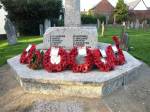
Click on an image for a larger picture
|
